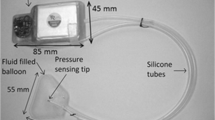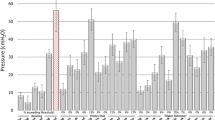Abstract
We recorded vaginal pressure in 12 women without risk factors for prolapse during two activity and exercise sessions, compared exercise and cough pressure, and evaluated method reproducibility and patterns of relative pressure. Portable urodynamic equipment, repeated measures descriptive design, and purposeful sampling were used with nonparametric analysis and visual comparison of pressure graphs. Mean participant age was 31.1 years (range 20–51), and mean body mass index was 22.7 (range 18.5–29.3). Mean pressures (in cm H2O): cough, 98.0 (48.0–133.7); standing, 24.0 (15.9–28.5); supine exercise, 34.0 (6.3–91.9); exercise machines, 37.0 (20.3–182.3). Repeated measures correlations for selected measures ranged from 0.66 (p ≤ 0.05) to 0.91 (p ≤ 0.01), and median within-woman coefficients of variation ranged from 3.8% to 7.2%. Individual pressure patterns were not consistent with patterns of group medians. We concluded that vaginal pressure measurement is reproducible in women without prolapse and that studied exercises generally produced lower pressure than cough, but individuals varied in pressure exerted. Individual variations warrant further study.





Similar content being viewed by others
References
Pate RP, Pratt M, Blair SN, Haskell WL, Macera CA, Bouchard C et al (1995) Physical activity and public health: a recommendation from the Centers for Disease Control and Prevention and the American College of Sports Medicine. JAMA 273:402–407
Boyles SH, Weber AM, Meyn L (2003) Procedures for pelvic organ prolapse in the United States, 1979–1997. Am J Obstet Gynecol 188:108–115
Bø K (2004) Urinary incontinence, pelvic floor dysfunction, exercise and sport. Sports Med 34:451–464
Bump RC, Norton PA (1998) Epidemiology and natural history of pelvic floor function. Obstet Gynecol Clin North Am 25:723–746
Whiteside JL, Weber AM, Meyn L, Walters MD (2004) Risk factors for prolapse recurrence after vaginal repair. Am J Obstet Gynecol 191:1533–1538
Rinne KM, Kirkinen PP (1999) What predisposes young women to genital prolapse? Eur J Obstet Gynecol Reprod Biol 84:23–25
Hendrix SL, Clark A, Nygaard I, Argaki A, Barnabei V, McTiernan A (2002) Pelvic organ prolapse in the Women’s Health Initiative: gravity and gravidity. Am J Obstet Gynecol 186:1160–1166
Moalli PA, Jones Ivy S, Meyn LA, Zyczynski HM (2003) Risk factors associated with pelvic floor disorders in women undergoing surgical repair. Obstet Gynecol 101(5 Pt 1):869–874
Arya LA, Novi JM, Shaunik A, Morgan MA, Bradley CS (2005) Pelvic organ prolapse, constipation, and dietary fiber intake in women: a case-control study. Am J Obstet Gynecol 192:1687–1691
Harvey MA, Johnston SL, Davies GAL (2004) Second trimester serum relaxin concentrations are associated with pelvic organ prolapse following childbirth. Poster session presented at the combined meeting of the American Urogynecologic Society and the Society of Gynecologic Surgeons, San Diego, CA, July 2004
O’Boyle AL, O’Boyle JD, Ricks RE, Patience TH, Calhoun B, Davis G (2003) The natural history of pelvic organ support in pregnancy. Int Urogynecol J Pelvic Floor Dysfunct 14:46–49
Woodman PJ, Swift SE, O’Boyle AL, Valley MT, Bland DR, Kahn MA, Schaffer JI (2006) Prevalence of severe pelvic organ prolapse in relation to job description and socioeconomic status: a multi-center cross-sectional study. Int Urogynecol J Pelvic Floor Dysfunct 17:340–345
Fitzgerald MP, Shisler S, Shott S, Brubaker L (2001) Physical limitations after gynecologic surgery. J Pelvic Surg 7:136–139
Curves (2005) About curves. Retrieved from http://www.chasefreedom.com/curvesforwomen.html, April 23, 2005
Nerli S, Viespi P (1997) The use of hydraulic resistance in rehabilitation: a review of the literature. J Sports Chiropr Rehabil 11(3):104–107, 131–132
Pereira MI, Gomes PS (2003) Movement velocity in resistance training. Sports Med 33:427–438
Wall LL, Hewitt JK, Helms MJ (1995) Are vaginal and rectal pressures equivalent approximations of one another for the purpose of performing subtracted cystometry? Obstet Gynecol 85:488–493
Cohen J (1988) Statistical power analysis for the behavioral sciences, 2nd edn. Erlbaum, Hillside, NJ
O’Dell K (2006) An exploratory study of vaginally measured intra-abdominal pressure change in women during activity and exercise. University Microfilms (UMI), http://www.umi.com, AAT 3234193
Bender R, Lange S (2001) Adjusting for multiple testing—when and how? J Clin Epidemiol 54:343–349
Grillner S, Nilsson J, Thorstensson A (1978) Intra-abdominal pressure changes during natural movements in man. Acta Physiol Scand 103:275–283
Weir LF, Nygaard IE, Wilken J, Bradt D, Janz KF (2006) Postoperative activity restrictions: any evidence? Obstet Gynecol 107:305–309
Noblett KL, Jensen JK, Ostergard DR (1997) The relationship of body mass index to intra-abdominal pressure as measured by multi-channel cystometry. Int Urogynecol J Pelvic Floor Dysfunct 8:323–326
Hagins M, Pietrek M, Sheikhzadeh A, Nordin M, Axen K (2004) The effects of breath control on intra-abdominal pressure during lifting tasks. Spine 29:464–469
Sharpey-Schafer EP (1953) Effects of coughing on intrathoracic pressure, arterial pressure, and peripheral blood flow. J Physiol 122:351–357
Acknowledgements
This study was funded by the Sigma Theta Tau Nursing Honor Society, the Iota Phi Chapter at Large, and the Rehabilitation Nurses Foundation. Thanks to Carol Bova Ph.D. for her mentorship and to Victoria Avedian and Francine Nicolaou, proprietors of the Shaping Zone—An Exercise Studio for Women.
Author information
Authors and Affiliations
Corresponding author
Rights and permissions
About this article
Cite this article
O’Dell, K.K., Morse, A.N., Crawford, S.L. et al. Vaginal pressure during lifting, floor exercises, jogging, and use of hydraulic exercise machines. Int Urogynecol J 18, 1481–1489 (2007). https://doi.org/10.1007/s00192-007-0387-8
Received:
Accepted:
Published:
Issue Date:
DOI: https://doi.org/10.1007/s00192-007-0387-8




